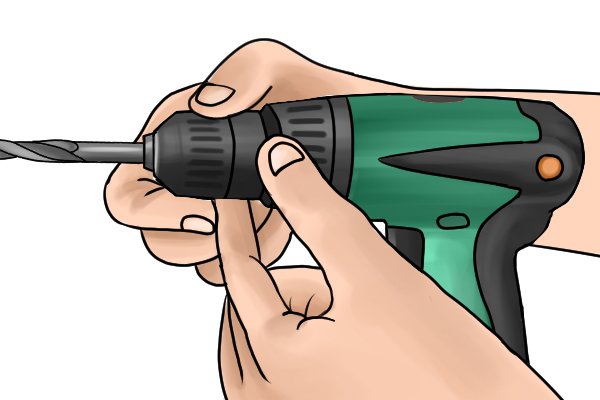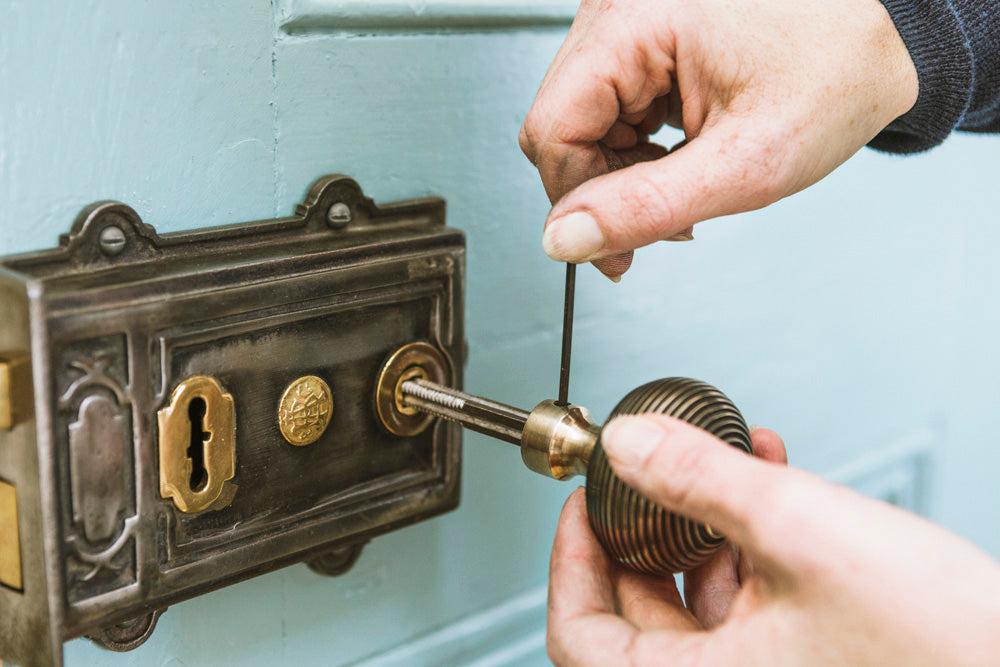A spindle lock is a simple yet essential tool used in various industries and DIY projects. It’s a mechanism designed to secure the spindle or shaft of a machine or tool in place, preventing it from rotating. This lock plays a crucial role in tasks like changing a saw blade or attaching accessories to power tools. By engaging the spindle lock, you can immobilize the spinning part, making it safer and easier to work on. Spindle locks are typically found on tools like drills, angle grinders, and routers.
What is a Spindle lock?
A spindle lock is a handy tool used to keep a power tool or machinery’s spindle or shaft from rotating while you’re changing accessories, like blades or bits. It’s a safety feature that prevents accidents by immobilizing the spinning parts.
To use a spindle lock, first, make sure the power tool is unplugged or turned off. Then, locate the lock button or lever on the tool, usually near the spindle. Push or activate the lock to hold the spindle in place securely. This action stops the rotation of the spindle.

The advantage of a spindle lock
A spindle lock is a handy feature found in many power tools, like drills and routers. It offers several advantages that can make your DIY projects smoother and safer.
Easy Bit Changes: With a spindle lock, changing bits becomes a breeze. You won’t need multiple tools or struggle to hold the spindle in place while tightening or loosening bits.
Enhanced Safety: Spindle locks prevent accidental starts when you’re changing accessories. This keeps you safe from unexpected tool engagement.
Faster Bit Swaps: Speed matters in woodworking and construction. A spindle lock speeds up bit changes, allowing you to stay productive without delays.
Consistent Precision: When you need precise cuts or holes, spindle locks ensure that your bit stays securely in place. This consistency is crucial for professional-looking results.
User-Friendly: Even if you’re not a seasoned DIYer, spindle locks are easy to use. You’ll appreciate the simplicity of changing bits without frustration.
Reduced Fatigue: The convenience of a spindle lock reduces strain on your hands and arms. You won’t have to exert extra force to keep the spindle steady.
Versatility: Spindle locks are common in various power tools, from drills to routers. This means you can enjoy their benefits across your tool collection.
Cost-Effective: Investing in tools with spindle locks can save you money in the long run. Fewer accidents mean less potential damage to your tools.
Improved Project Outcomes: Whether you’re crafting furniture or tackling home repairs, spindle locks contribute to cleaner, more precise work.
Peace of Mind: Knowing that spindle locks equip your tools adds an extra layer of confidence to your DIY endeavors.
When to use spindle lock?
Knowing when to use the spindle lock in your power tools can greatly enhance your DIY projects. Here are more detailed explanations for various situations where you should use the spindle lock:
Bit Changes: When you’re swapping out drill bits or router bits, use the spindle lock. It prevents the spindle from rotating, making it effortless to secure or release the bit with just one hand.
Tightening or Loosening Screws: When dealing with tough screws that require extra torque, engage the spindle lock. This allows you to hold the tool steady while you apply the necessary force to tighten or loosen the fastener effectively.
Depth Adjustments: For tasks that require precise depth adjustments, like setting the depth of a drill bit or router bit, the spindle lock is essential. It ensures that the bit stays securely in place, maintaining the accuracy of your work.
Changing Accessories: Whenever you need to change accessories on your power tool, such as switching from a cutting blade to a sanding disc, it’s important to lock the spindle. This keeps the accessory securely in position, preventing any wobbling or shifting during operation.
Maintenance: During routine maintenance of your power tool, like cleaning or replacing parts, the spindle lock comes in handy. It immobilizes the spindle, making it easier and safer to perform maintenance tasks.
Safety: Whenever your power tool is not in active use, always engage the spindle lock. This precautionary measure prevents accidental starts, reducing the risk of injury. It’s a simple yet crucial step in ensuring safety while working with power tools.
What to consider when buying a spindle lock?
When you’re in the market for a spindle lock, there are several important factors to consider. This handy device plays a crucial role in securing your doors and ensuring your home’s safety. Here’s what you need to keep in mind to make an informed purchase:
Compatibility
Start by measuring the dimensions of your door. This includes both the thickness and the diameter of the hole where you will install the spindle lock. Knowing these measurements is crucial because spindle locks come in various sizes to fit different doors. Choosing the wrong size can lead to installation issues and security vulnerabilities.
Materials
The material of the spindle lock affects its durability and resistance to wear and tear. Stainless steel and brass are excellent choices as they are known for their strength and corrosion resistance. These materials ensure that your lock will withstand the test of time and weather conditions.
Security
Assess the lock’s security features. Look for spindle locks with advanced security mechanisms, such as anti-pick and anti-drill features. These additional layers of security deter burglars from attempting to tamper with the lock.
Key Type
Decide whether you prefer a traditional key-based lock or a keyless entry system. Keyless options often provide added convenience, as you can unlock your door using a code, fingerprint, or smartphone app. However, it’s wise to have a backup key system in case of power or electronic malfunctions.
Installation
Consider your DIY skills when selecting a spindle lock. Some locks are more complex to install than others. If you’re not confident in your abilities, it’s advisable to hire a professional locksmith to ensure the lock is installed correctly for maximum security.
Brand Reputation
Research different brands and check customer reviews. A reputable brand is more likely to produce reliable locks that meet industry standards for quality and security. You can rely on feedback from other customers to gauge a brand’s reliability.
Price Range
Determine your budget before shopping. Spindle locks are available at various price points, so having a budget in mind will help you narrow down your options and find a lock that offers the right balance of features and affordability.
Lock Style
Spindle locks come in an array of styles and finishes. Choose one that not only enhances your door’s security but also complements your home’s aesthetic. You’ll want a lock that blends seamlessly with your overall decor.
Warranty
Investigate the warranty offered by the manufacturer. A longer warranty period indicates the manufacturer’s confidence in their product’s durability and performance. A solid warranty can provide peace of mind in case you encounter any issues with your lock.
Maintenance
Different locks require varying levels of maintenance. Some may need regular lubrication or cleaning to function optimally. Consider how much time and effort you’re willing to invest in maintaining your spindle lock when making your selection.
Lock Grade
Look for locks that meet industry standards, such as ANSI/BHMA grading. These standards assign a grade to locks based on their durability and performance. Higher-grade locks are generally more robust and reliable.
Additional Features
Some spindle locks offer extra features, such as built-in alarms or remote access capabilities. Evaluate whether these features align with your specific security needs and preferences.
Local Regulations
Check with local authorities or building codes to see if there are any regulations governing the type of locks you can use on your doors. To prevent any legal problems, adherence to these rules is crucial.
Customer Support
Look at how much customer service the manufacturer offers. In case you encounter any problems or have questions about your lock, responsive and helpful customer support can make a significant difference in your overall experience.
Ease of Use
Finally, test the lock’s ease of use before finalizing your purchase. It should be intuitive and straightforward to operate daily, ensuring that you and your family can easily secure and access your home.

FAQs
Are spindle locks suitable for all types of doors?
Spindle locks come in various sizes. Measure your door’s thickness and hole diameter to ensure compatibility. This way, you can find the right spindle lock that fits your specific door.
What security features should I look for in a spindle lock?
For enhanced security, choose a spindle lock with anti-pick and anti-drill features. These features make it more difficult for burglars to tamper with the lock, providing extra protection for your home.
Can I install a spindle lock myself, or do I need a professional?
While some may install it themselves, hiring a professional locksmith is advisable for a secure installation. Professionals ensure that the lock is correctly placed, enhancing its effectiveness.
Do spindle locks require regular maintenance?
Yes, spindle locks may need occasional lubrication to stay in top shape. Follow the manufacturer’s instructions for maintenance. It’s a simple task that can prolong the life of your lock.
